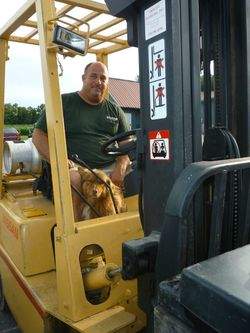By Evan Dawson, Finger Lakes Editor
Dave Stamp, the vineyard manager at Lakewood Vineyards on Seneca Lake, wears shorts every day during harvest, which he says "might be tradition, and it might be just stupid." If it's the latter, then it's one of the only stupid things Dave does in the vineyard; everything else is carefully considered and based on 25 years of experience. That doesn't mean he makes the right call every time, and it doesn't mean every other grower will agree with his decisions.
But it does mean that there are few people more qualified to tell the story of this vintage than Dave. Eventually, when consumers taste the best wines of 2011, they might not fully understand just how much work went into their creation. So I wanted to talk to Dave Stamp about how it all went down.
By the way, Dave is an exceedingly nice and soft-spoken guy. He'll give you his thoughts, even on controversial subjects, but he never seeks to bring anyone else down. It's occasionally technical and always instructive for me and, I hope, for regular consumers who don't know all the details of growing.
NYCR: You've said that everyone will have a "mud story." What do you mean?
DS: That was the vintage. Just a lot of rain! As far as getting the fruit off, that was fun. It was muddy. We were down the road in our loading area, and it got so chewed up that turning the steering wheel was just funny. The machines were sliding on the hill, and it was a lot of work to keep the thing going where you wanted it!
NYCR: Do you have any fruit still hanging?
DS: Everything is in. We didn't feel it was going to be a good late-harvest year. With the rain and pressure, we figured it was better to cut our losses and get everything in.
NYCR: The rainy spring cranked up disease pressure, we're told.
DS: Right.
NYCR: Growers have told us that they had to spray more often this year. What kinds of sprays, exactly? What was your approach?
DS: Spring was wetter than normal, which was inconvenient. Summer dried off, a lot of heat, and we were smiling for a while. But we knew there would be disease somewhere after the spring. In September we had way too much rain. We had some splitting problems. But we think we kept the lid on it pretty well.
When you get that much water, the berry gets wet, and it pumps that water up, and the skin can't handle it. It splits. Then you get sour rot in there. You can't have a lot of it before it really starts to affect the wine.
We use sulphur for powdery mildew. It's a very nice product, very old, and it works. We also use newer stuff like Pristine and Resis, which attack proteins in the cell wall, and destroy the fungus that way. Those are prone to resistance, so we use them sparingly. Captan is good for downey mildew. It's a product that serves as a workhorse. There's Abound, which is a sterile inhibitor. It kills a lot of different diseases, black rot, powdery mildew.
NYCR: Is this the kind of vintage that affirms many growers' belief that organic viticulture can't be done in this region?
DS: You don't see organic growing around here. And somebody could be organic, and it doesn't mean they don't spray. It's just a different set of products. They're a little limited in what they can use. Some of the stuff they're putting on has not been tested like we test regular pesticides. I don't think that's a great idea. In the end, I think it's better to go with a mindset we call "sustainable." Look at the whole picture of things and choose the product that will work best for you with the least amount of side effects.
NYCR: Were you able to pick on dry days?
DS: For the most part, we picked when it was dry. We were fortunate that when we got the big rains, the stuff that was prone to rot, it was inside the harvest window, so we went ahead and picked them right before the rains. My brother would have preferred another brick on the riesling, sure, but we made the decision to get it in and avoid rot. That's the compromise. Just something we had to do this time around.
NYCR: We had two dry, warm stretches, two windows during harvest. One was in late September, the other in early October. How significant was that?
DS: Those two-dry stretches helped us out a lot. No question about it. We weren't getting high brix, but the acids still were down. Low acid, low brix, and the flavors came through. Things balanced out nicely. In the end, I think people will be happy with this vintage.
NYCR: With the experience you've gained, do you see a difference between hand picking and machine picking?
DS: Well, we hand pick pinot noir, and just about everything else is machine picked. When you hand pick something, it sits on the ground, and it's there for a good chunk of the day before anything happens with it. When you machine pick it, it's often on the press within the hour. For me, it often boils down to what you've done in the vineyard. At the end of the day, I'm just not seeing hand-picked wines win all the awards. The machine-picked wines win lots of awards. The newer machines picks things a lot cleaner than they used to, so what matters most is whether you've done the right things in the vineyard.
NYCR: Are you glad it's over?
DS: (laughs) Well, it was a good-sized harvest for us, a lot of fruit. It was a lot of work! But maybe that's just grape-growing in the northeast.

